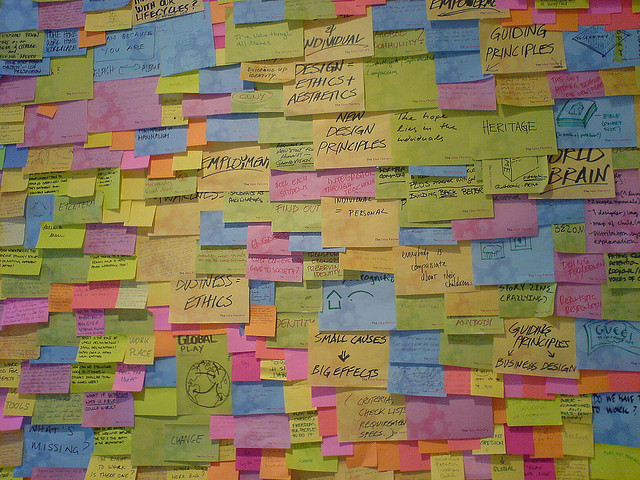
If you’ve ever sat through a Monday morning meeting and thought, “I feel like my time could be better used in some other way,” you’re not wrong; meetings are literally a billion-dollar time-waster in the corporate world. But what makes a meeting frivolous isn’t the gathering of everyone together in one board room — often, meetings are ineffective simply because they fail to produce any new ideas. Which is strange, because group thinking can actually be one of the best ways to spur the generation of new solutions to old problems. If your meetings continue to be fruitless, it might not be the meeting itself, but rather, a lack of effective idea-creating tactics.
The principles of a proper brainstorming session can be hard to nail down, because everyone’s mind works a little differently. However, there are some tried-and-true best practices — and some pretty innovative approaches — that can help you maximize your meeting time, by encouraging brainstorming that actively creates answers and solutions.
Details like time of day (late morning is usually best, though some people don’t work well on an empty stomach and prefer to meet during or after lunch) and surroundings (sitting around a proper table is popular, but so is heading out to a park or up to a roof) usually come down to judgement calls, and should be decided by your team. But there are some generally agreed-upon practices that can help make the most of your time.

International design and consulting firm IDEO is widely recognized for their contributions to the tech world (including the first Apple mouse), which often come as the result of brainstorming sessions. However, in a Quora answer on the subject of effective brainstorming, Client Director James Moed explained that a big part of their success was the ability to structure their time.
“Brainstorms are typically something we do in response to a specific design provocation…Usually, they’re actively facilitated,” James writes, “The convening person or team is hoping to get a certain amount of new thinking for their project, so they will time events and change topic as needed.”
Richard Branson echoes the importance of focus.
“While everyone gets an opportunity to think creatively during a brainstorming session, there should be a practical purpose for your gathering, or else you may end up going nowhere,” he explained in a 2012 piece for Entrepreneur. “When the conversation strays, remind everyone about the problem you’re trying to solve, and keep working toward that objective.”
Being strict on time isn’t the same with actively policing ideas, though. Fostering an environment of encouragement is essential if you want to everyone on the team to come up with their best ideas. Sure, some things may come out of left field, but, as Isaac Asimov wrote, the most creative people often “seem eccentric,” because they are generating concepts that “fly in the face of reason, authority, and common sense.”
In that vein, Rob O’Connor of Stylorouge says in a piece for CreativeBloq that the key to a great brainstorm is allowing everyone to behave “unselfconsciously,” even at times when a meeting is not technically in session.
“You don’t have to meet to generate ideas – it can also be part of a more general catch-up.”
Many offices have a few bold personalities, but try to make a conscious effort to allow everyone a chance to speak at your next brainstorm. Stephen Desilets, Creative Director at EA Mobile, notes that even just talking through an idea can help clarify it and make it stronger.
 “It’s anecdotal,” he writes, “but I believe that hearing yourself speak about a concept allows you to process the idea through different parts of the brain than when using an ‘inner monologue’ solely, while thinking through a problem.
“It’s anecdotal,” he writes, “but I believe that hearing yourself speak about a concept allows you to process the idea through different parts of the brain than when using an ‘inner monologue’ solely, while thinking through a problem.
Rob also encourages employing tested techniques which are known to encourage creativity, like allowing for doodling.
“Some studios lose their clutter, but we’ve got paints, brushes, paperboards, and scalpels for people to use with their hands. When your designs exist on a computer you can start to feel like it’s not a physical experience, so these are reminders,” he explains.
Despite the popularity of “hackathons” and other all-day meetings, almost every great thinker agrees that one of the best things you can do to encourage good ideas is to let your staff do something else, even just for a few minutes.
UCB sketch writer Geoff Garlock told Inc that he takes the idea of the “shower moment” to literal levels.
“Take a shower, or a bath, or a spongebath, whatever you do to cleanse yourself of the daily grime and the grime of trying to come up with new ideas,” he explained, “When we let our brains loose, then we start to see the reasons that we think the world is absurd.”
“Enjoy a change of scenery for at least for half an hour before you start working, and remember to take breaks,” advises Richard Branson, adding that “diversions like playing a game, exercising or listening to music might help everyone to relax and then go back to work refreshed.”


